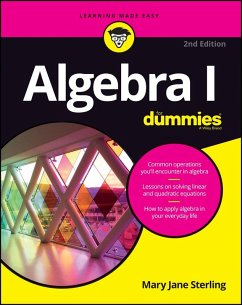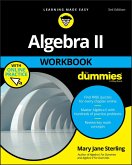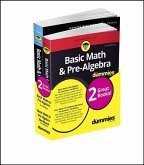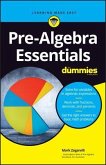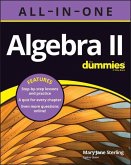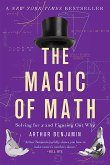Mary Jane Sterling (Bradley University, Peoria, IL)
Algebra I for Dummies
22,99 €
inkl. MwSt.
Versandfertig in 2-4 Wochen

11 °P sammeln
Mary Jane Sterling (Bradley University, Peoria, IL)
Algebra I for Dummies
- Broschiertes Buch
- Merkliste
- Auf die Merkliste
- Bewerten Bewerten
- Teilen
- Produkt teilen
- Produkterinnerung
- Produkterinnerung
Algebra I For Dummies, 2nd Edition (9781119293576) was previously published as Algebra I For Dummies, 2nd Edition (9780470559642). While this version features a new Dummies cover and design, the content is the same as the prior release and should not be considered a new or updated product.
Andere Kunden interessierten sich auch für
![Algebra II Workbook for Dummies Algebra II Workbook for Dummies]() Mary Jane Sterling (Bradley University, Peoria, IL)Algebra II Workbook for Dummies22,99 €
Mary Jane Sterling (Bradley University, Peoria, IL)Algebra II Workbook for Dummies22,99 €![Basic Math & Pre-Algebra for Dummies Book + Workbook Bundle Basic Math & Pre-Algebra for Dummies Book + Workbook Bundle]() Mark ZegarelliBasic Math & Pre-Algebra for Dummies Book + Workbook Bundle26,99 €
Mark ZegarelliBasic Math & Pre-Algebra for Dummies Book + Workbook Bundle26,99 €![Pre-Algebra Essentials for Dummies Pre-Algebra Essentials for Dummies]() Mark ZegarelliPre-Algebra Essentials for Dummies16,99 €
Mark ZegarelliPre-Algebra Essentials for Dummies16,99 €![Algebra II All-In-One for Dummies Algebra II All-In-One for Dummies]() Mary Jane Sterling (Bradley University, Peoria, IL)Algebra II All-In-One for Dummies30,99 €
Mary Jane Sterling (Bradley University, Peoria, IL)Algebra II All-In-One for Dummies30,99 €![Fractions for Dummies Fractions for Dummies]() Mark ZegarelliFractions for Dummies15,99 €
Mark ZegarelliFractions for Dummies15,99 €![The Magic of Math The Magic of Math]() Arthur BenjaminThe Magic of Math24,99 €
Arthur BenjaminThe Magic of Math24,99 €![Basic Algebra I Basic Algebra I]() Nathan JacobsonBasic Algebra I24,99 €
Nathan JacobsonBasic Algebra I24,99 €-
-
-
Algebra I For Dummies, 2nd Edition (9781119293576) was previously published as Algebra I For Dummies, 2nd Edition (9780470559642). While this version features a new Dummies cover and design, the content is the same as the prior release and should not be considered a new or updated product.
Hinweis: Dieser Artikel kann nur an eine deutsche Lieferadresse ausgeliefert werden.
Hinweis: Dieser Artikel kann nur an eine deutsche Lieferadresse ausgeliefert werden.
Produktdetails
- Produktdetails
- Verlag: John Wiley & Sons Inc
- 2 ed
- Seitenzahl: 384
- Erscheinungstermin: 7. Juni 2016
- Englisch
- Abmessung: 236mm x 187mm x 25mm
- Gewicht: 712g
- ISBN-13: 9781119293576
- ISBN-10: 111929357X
- Artikelnr.: 44961621
- Herstellerkennzeichnung
- Libri GmbH
- Europaallee 1
- 36244 Bad Hersfeld
- gpsr@libri.de
- Verlag: John Wiley & Sons Inc
- 2 ed
- Seitenzahl: 384
- Erscheinungstermin: 7. Juni 2016
- Englisch
- Abmessung: 236mm x 187mm x 25mm
- Gewicht: 712g
- ISBN-13: 9781119293576
- ISBN-10: 111929357X
- Artikelnr.: 44961621
- Herstellerkennzeichnung
- Libri GmbH
- Europaallee 1
- 36244 Bad Hersfeld
- gpsr@libri.de
Mary Jane Sterling (Peoria, Illinois) is the author of Algebra I For Dummies, Algebra Workbook For Dummies, Algebra II For Dummies, Algebra II Workbook For Dummies, and five other For Dummies books. She has been at Bradley University in Peoria, Illinois for nearly 30 years, teaching algebra, business calculus, geometry, finite mathematics, and whatever interesting material comes her way.
Introduction 1
About This Book 1
Conventions Used in This Book 2
What You're Not to Read 2
Foolish Assumptions 3
How This Book Is Organized 3
Part 1: Starting Off with the Basics 3
Part 2: Figuring Out Factoring 4
Part 3: Working Equations 4
Part 4: Applying Algebra 4
Part 5: The Part of Tens 5
Icons Used in This Book 5
Where to Go from Here 6
Part 1: Starting off with the Basics 7
Chapter 1: Assembling Your Tools 9
Beginning with the Basics: Numbers 10
Really real numbers 10
Counting on natural numbers 10
Wholly whole numbers 11
Integrating integers 12
Being reasonable: Rational numbers 12
Restraining irrational numbers 12
Picking out primes and composites 13
Speaking in Algebra 13
Taking Aim at Algebra Operations 14
Deciphering the symbols 14
Grouping 15
Defining relationships 16
Taking on algebraic tasks 16
Chapter 2: Assigning Signs: Positive and Negative Numbers 19
Showing Some Signs 20
Picking out positive numbers 20
Making the most of negative numbers 20
Comparing positives and negatives 21
Zeroing in on zero 22
Going In for Operations 22
Breaking into binary operations 22
Introducing non-binary operations 23
Operating with Signed Numbers 25
Adding like to like: Same-signed numbers 25
Adding different signs 26
Subtracting signed numbers 27
Multiplying and dividing signed numbers 29
Working with Nothing: Zero and Signed Numbers 31
Associating and Commuting with Expressions 31
Reordering operations: The commutative property 32
Associating expressions: The associative property 33
Chapter 3: Figuring Out Fractions and Dealing with Decimals 35
Pulling Numbers Apart and Piecing Them Back Together 36
Making your bow to proper fractions 36
Getting to know improper fractions 37
Mixing it up with mixed numbers 37
Following the Sterling Low-Fraction Diet 38
Inviting the loneliest number one 39
Figuring out equivalent fractions 40
Realizing why smaller or fewer is better 41
Preparing Fractions for Interactions 43
Finding common denominators 43
Working with improper fractions 45
Taking Fractions to Task 46
Adding and subtracting fractions 46
Multiplying fractions 47
Dividing fractions 50
Dealing with Decimals 51
Changing fractions to decimals 52
Changing decimals to fractions 53
Chapter 4: Exploring Exponents and Raising Radicals 55
Multiplying the Same Thing Over and Over and Over 55
Powering up exponential notation 56
Comparing with exponents 57
Taking notes on scientific notation 58
Exploring Exponential Expressions 60
Multiplying Exponents 65
Dividing and Conquering 66
Testing the Power of Zero 66
Working with Negative Exponents 67
Powers of Powers 68
Squaring Up to Square Roots 69
Chapter 5: Doing Operations in Order and Checking Your Answers 73
Ordering Operations 74
Gathering Terms with Grouping Symbols 76
Checking Your Answers 78
Making sense or cents or scents 79
Plugging in to get a charge of your answer 79
Curbing a Variable's Versatility 80
Representing numbers with letters 81
Attaching factors and coefficients 82
Interpreting the operations 82
Doing the Math 83
Adding and subtracting variables 84
Adding and subtracting with powers 85
Multiplying and Dividing Variables 86
Multiplying variables 86
Dividing variables 87
Doing it all 88
Part 2: Figuring Out Factoring 91
Chapter 6: Working with Numbers in Their Prime 93
Beginning with the Basics 94
Composing Composite Numbers 95
Writing Prime Factorizations 96
Dividing while standing on your head 96
Getting to the root of primes with a tree 98
Wrapping your head around the rules of divisibility 99
Getting Down to the Prime Factor 100
Taking primes into account 100
Pulling out factors and leaving the rest 103
Chapter 7: Sharing the Fun: Distribution 107
Giving One to Each 108
Distributing first 109
Adding first 109
Distributing Signs 110
Distributing positives 110
Distributing negatives 111
Reversing the roles in distributing 112
Mixing It Up with Numbers and Variables 113
Negative exponents yielding fractional answers 115
Working with fractional powers 115
Distributing More Than One Term 117
Distributing binomials 117
Distributing trinomials 118
Multiplying a polynomial times another polynomial 119
Making Special Distributions 120
Recognizing the perfectly squared binomial 120
Spotting the sum and difference of the same two terms 121
Working out the difference and sum of two cubes 123
Chapter 8: Getting to First Base with Factoring 127
Factoring 127
Factoring out numbers 128
Factoring out variables 130
Unlocking combinations of numbers and variables 131
Changing factoring into a division problem 133
Grouping Terms 134
Chapter 9: Getting the Second Degree 139
The Standard Quadratic Expression 140
Reining in Big and Tiny Numbers 141
FOILing 142
FOILing basics 142
FOILed again, and again 143
Applying FOIL to a special product 146
UnFOILing 147
Unwrapping the FOILing package 148
Coming to the end of the FOIL roll 151
Making Factoring Choices 152
Combining unFOIL and the greatest common factor 153
Grouping and unFOILing in the same package 154
Chapter 10: Factoring Special Cases 157
Befitting Binomials 157
Factoring the difference of two perfect squares 158
Factoring the difference of perfect cubes 159
Factoring the sum of perfect cubes 162
Tinkering with Multiple Factoring Methods 163
Starting with binomials 163
Ending with binomials 164
Knowing When to Quit 165
Incorporating the Remainder Theorem 166
Synthesizing with synthetic division 166
Choosing numbers for synthetic division 167
Part 3: Working Equations 169
Chapter 11: Establishing Ground Rules for Solving Equations 171
Creating the Correct Setup for Solving Equations 172
Keeping Equations Balanced 172
Balancing with binary operations 173
Squaring both sides and suffering the consequences 174
Taking a root of both sides 175
Undoing an operation with its opposite 176
Solving with Reciprocals 176
Making a List and Checking It Twice 179
Doing a reality check 179
Thinking like a car mechanic when checking your work 180
Finding a Purpose 181
Chapter 12: Solving Linear Equations 183
Playing by the Rules 184
Solving Equations with Two Terms 184
Devising a method using division 185
Making the most of multiplication 186
Reciprocating the invitation 188
Extending the Number of Terms to Three 189
Eliminating the extra constant term 189
Vanquishing the extra variable term 190
Simplifying to Keep It Simple 191
Nesting isn't for the birds 192
Distributing first 192
Multiplying or dividing before distributing 194
Featuring Fractions 196
Promoting practical proportions 196
Transforming fractional equations into proportions 198
Solving for Variables in Formulas 199
Chapter 13: Taking a Crack at Quadratic Equations 203
Squaring Up to Quadratics 204
Rooting Out Results from Quadratic Equations 206
Factoring for a Solution 208
Zeroing in on the multiplication property of zero 209
Assigning the greatest common factor and multiplication property of zero to
solving quadratics 210
Solving Quadratics with Three Terms 211
Applying Quadratic Solutions 217
Figuring Out the Quadratic Formula 219
Imagining the Worst with Imaginary Numbers 221
Chapter 14: Distinguishing Equations with Distinctive Powers 223
Queuing Up to Cubic Equations 224
Solving perfectly cubed equations 224
Working with the not-so-perfectly cubed 225
Going for the greatest common factor 226
Grouping cubes 228
Solving cubics with integers 228
Working Quadratic-Like Equations 230
Rooting Out Radicals 234
Powering up both sides 235
Squaring both sides twice 237
Solving Synthetically 239
Chapter 15: Rectifying Inequalities 243
Translating between Inequality and Interval Notation 244
Intervening with interval notation 244
Grappling with graphing inequalities 246
Operating on Inequalities 247
Adding and subtracting inequalities 247
Multiplying and dividing inequalities 248
Solving Linear Inequalities 249
Working with More Than Two Expressions 250
Solving Quadratic and Rational Inequalities 252
Working without zeros 255
Dealing with more than two factors 255
Figuring out fractional inequalities 256
Working with Absolute-Value Inequalities 258
Working absolute-value equations 258
Working absolute-value inequalities 260
Part 4: Applying Algebra 263
Chapter 16: Taking Measure with Formulas 265
Measuring Up 265
Finding out how long: Units of length 266
Putting the Pythagorean theorem to work 267
Working around the perimeter 269
Spreading Out: Area Formulas 273
Laying out rectangles and squares 273
Tuning in triangles 274
Going around in circles 276
Pumping Up with Volume Formulas 276
Prying into prisms and boxes 277
Cycling cylinders 277
Scaling a pyramid 278
Pointing to cones 279
Rolling along with spheres 279
Chapter 17: Formulating for Profit and Pleasure 281
Going the Distance with Distance Formulas 282
Calculating Interest and Percent 283
Compounding interest formulas 284
Gauging taxes and discounts 286
Working Out the Combinations and Permutations 287
Counting down to factorials 288
Counting on combinations 288
Ordering up permutations 290
Chapter 18: Sorting Out Story Problems 291
Setting Up to Solve Story Problems 292
Working around Perimeter, Area, and Volume 294
Parading out perimeter and arranging area 294
Adjusting the area 295
Pumping up the volume 297
Making Up Mixtures 300
Mixing up solutions 301
Tossing in some solid mixtures 302
Investigating investments and interest 302
Going for the green: Money 304
Going the Distance 305
Figuring distance plus distance 306
Figuring distance and fuel 307
Going 'Round in Circles 307
Chapter 19: Going Visual: Graphing 311
Graphing Is Good 312
Grappling with Graphs 313
Making a point 314
Ordering pairs, or coordinating coordinates 315
Actually Graphing Points 316
Graphing Formulas and Equations 317
Lining up a linear equation 317
Going around in circles with a circular graph 318
Throwing an object into the air 319
Curling Up with Parabolas 321
Trying out the basic parabola 321
Putting the vertex on an axis 322
Sliding and multiplying 324
Chapter 20: Lining Up Graphs of Lines 327
Graphing a Line 327
Graphing the equation of a line 329
Investigating Intercepts 332
Sighting the Slope 333
Formulating slope 335
Combining slope and intercept 337
Getting to the slope-intercept form 337
Graphing with slope-intercept 338
Marking Parallel and Perpendicular Lines 339
Intersecting Lines 341
Graphing for intersections 341
Substituting to find intersections 342
Part 5: The Part of Tens 345
Chapter 21: The Ten Best Ways to Avoid Pitfalls 347
Keeping Track of the Middle Term 348
Distributing: One for You and One for Me 348
Breaking Up Fractions (Breaking Up Is Hard to Do) 348
Renovating Radicals 349
Order of Operations 349
Fractional Exponents 349
Multiplying Bases Together 350
A Power to a Power 350
Reducing for a Better Fit 351
Negative Exponents 351
Chapter 22: The Ten Most Famous Equations 353
Albert Einstein's Theory of Relativity 353
The Pythagorean Theorem 354
The Value of e 354
Diameter and Circumference Related with Pi 354
Isaac Newton's Formula for the Force of Gravity 355
Euler's Identity 355
Fermat's Last Theorem 356
Monthly Loan Payments 356
The Absolute-Value Inequality 356
The Quadratic Formula 357
Index 359
About This Book 1
Conventions Used in This Book 2
What You're Not to Read 2
Foolish Assumptions 3
How This Book Is Organized 3
Part 1: Starting Off with the Basics 3
Part 2: Figuring Out Factoring 4
Part 3: Working Equations 4
Part 4: Applying Algebra 4
Part 5: The Part of Tens 5
Icons Used in This Book 5
Where to Go from Here 6
Part 1: Starting off with the Basics 7
Chapter 1: Assembling Your Tools 9
Beginning with the Basics: Numbers 10
Really real numbers 10
Counting on natural numbers 10
Wholly whole numbers 11
Integrating integers 12
Being reasonable: Rational numbers 12
Restraining irrational numbers 12
Picking out primes and composites 13
Speaking in Algebra 13
Taking Aim at Algebra Operations 14
Deciphering the symbols 14
Grouping 15
Defining relationships 16
Taking on algebraic tasks 16
Chapter 2: Assigning Signs: Positive and Negative Numbers 19
Showing Some Signs 20
Picking out positive numbers 20
Making the most of negative numbers 20
Comparing positives and negatives 21
Zeroing in on zero 22
Going In for Operations 22
Breaking into binary operations 22
Introducing non-binary operations 23
Operating with Signed Numbers 25
Adding like to like: Same-signed numbers 25
Adding different signs 26
Subtracting signed numbers 27
Multiplying and dividing signed numbers 29
Working with Nothing: Zero and Signed Numbers 31
Associating and Commuting with Expressions 31
Reordering operations: The commutative property 32
Associating expressions: The associative property 33
Chapter 3: Figuring Out Fractions and Dealing with Decimals 35
Pulling Numbers Apart and Piecing Them Back Together 36
Making your bow to proper fractions 36
Getting to know improper fractions 37
Mixing it up with mixed numbers 37
Following the Sterling Low-Fraction Diet 38
Inviting the loneliest number one 39
Figuring out equivalent fractions 40
Realizing why smaller or fewer is better 41
Preparing Fractions for Interactions 43
Finding common denominators 43
Working with improper fractions 45
Taking Fractions to Task 46
Adding and subtracting fractions 46
Multiplying fractions 47
Dividing fractions 50
Dealing with Decimals 51
Changing fractions to decimals 52
Changing decimals to fractions 53
Chapter 4: Exploring Exponents and Raising Radicals 55
Multiplying the Same Thing Over and Over and Over 55
Powering up exponential notation 56
Comparing with exponents 57
Taking notes on scientific notation 58
Exploring Exponential Expressions 60
Multiplying Exponents 65
Dividing and Conquering 66
Testing the Power of Zero 66
Working with Negative Exponents 67
Powers of Powers 68
Squaring Up to Square Roots 69
Chapter 5: Doing Operations in Order and Checking Your Answers 73
Ordering Operations 74
Gathering Terms with Grouping Symbols 76
Checking Your Answers 78
Making sense or cents or scents 79
Plugging in to get a charge of your answer 79
Curbing a Variable's Versatility 80
Representing numbers with letters 81
Attaching factors and coefficients 82
Interpreting the operations 82
Doing the Math 83
Adding and subtracting variables 84
Adding and subtracting with powers 85
Multiplying and Dividing Variables 86
Multiplying variables 86
Dividing variables 87
Doing it all 88
Part 2: Figuring Out Factoring 91
Chapter 6: Working with Numbers in Their Prime 93
Beginning with the Basics 94
Composing Composite Numbers 95
Writing Prime Factorizations 96
Dividing while standing on your head 96
Getting to the root of primes with a tree 98
Wrapping your head around the rules of divisibility 99
Getting Down to the Prime Factor 100
Taking primes into account 100
Pulling out factors and leaving the rest 103
Chapter 7: Sharing the Fun: Distribution 107
Giving One to Each 108
Distributing first 109
Adding first 109
Distributing Signs 110
Distributing positives 110
Distributing negatives 111
Reversing the roles in distributing 112
Mixing It Up with Numbers and Variables 113
Negative exponents yielding fractional answers 115
Working with fractional powers 115
Distributing More Than One Term 117
Distributing binomials 117
Distributing trinomials 118
Multiplying a polynomial times another polynomial 119
Making Special Distributions 120
Recognizing the perfectly squared binomial 120
Spotting the sum and difference of the same two terms 121
Working out the difference and sum of two cubes 123
Chapter 8: Getting to First Base with Factoring 127
Factoring 127
Factoring out numbers 128
Factoring out variables 130
Unlocking combinations of numbers and variables 131
Changing factoring into a division problem 133
Grouping Terms 134
Chapter 9: Getting the Second Degree 139
The Standard Quadratic Expression 140
Reining in Big and Tiny Numbers 141
FOILing 142
FOILing basics 142
FOILed again, and again 143
Applying FOIL to a special product 146
UnFOILing 147
Unwrapping the FOILing package 148
Coming to the end of the FOIL roll 151
Making Factoring Choices 152
Combining unFOIL and the greatest common factor 153
Grouping and unFOILing in the same package 154
Chapter 10: Factoring Special Cases 157
Befitting Binomials 157
Factoring the difference of two perfect squares 158
Factoring the difference of perfect cubes 159
Factoring the sum of perfect cubes 162
Tinkering with Multiple Factoring Methods 163
Starting with binomials 163
Ending with binomials 164
Knowing When to Quit 165
Incorporating the Remainder Theorem 166
Synthesizing with synthetic division 166
Choosing numbers for synthetic division 167
Part 3: Working Equations 169
Chapter 11: Establishing Ground Rules for Solving Equations 171
Creating the Correct Setup for Solving Equations 172
Keeping Equations Balanced 172
Balancing with binary operations 173
Squaring both sides and suffering the consequences 174
Taking a root of both sides 175
Undoing an operation with its opposite 176
Solving with Reciprocals 176
Making a List and Checking It Twice 179
Doing a reality check 179
Thinking like a car mechanic when checking your work 180
Finding a Purpose 181
Chapter 12: Solving Linear Equations 183
Playing by the Rules 184
Solving Equations with Two Terms 184
Devising a method using division 185
Making the most of multiplication 186
Reciprocating the invitation 188
Extending the Number of Terms to Three 189
Eliminating the extra constant term 189
Vanquishing the extra variable term 190
Simplifying to Keep It Simple 191
Nesting isn't for the birds 192
Distributing first 192
Multiplying or dividing before distributing 194
Featuring Fractions 196
Promoting practical proportions 196
Transforming fractional equations into proportions 198
Solving for Variables in Formulas 199
Chapter 13: Taking a Crack at Quadratic Equations 203
Squaring Up to Quadratics 204
Rooting Out Results from Quadratic Equations 206
Factoring for a Solution 208
Zeroing in on the multiplication property of zero 209
Assigning the greatest common factor and multiplication property of zero to
solving quadratics 210
Solving Quadratics with Three Terms 211
Applying Quadratic Solutions 217
Figuring Out the Quadratic Formula 219
Imagining the Worst with Imaginary Numbers 221
Chapter 14: Distinguishing Equations with Distinctive Powers 223
Queuing Up to Cubic Equations 224
Solving perfectly cubed equations 224
Working with the not-so-perfectly cubed 225
Going for the greatest common factor 226
Grouping cubes 228
Solving cubics with integers 228
Working Quadratic-Like Equations 230
Rooting Out Radicals 234
Powering up both sides 235
Squaring both sides twice 237
Solving Synthetically 239
Chapter 15: Rectifying Inequalities 243
Translating between Inequality and Interval Notation 244
Intervening with interval notation 244
Grappling with graphing inequalities 246
Operating on Inequalities 247
Adding and subtracting inequalities 247
Multiplying and dividing inequalities 248
Solving Linear Inequalities 249
Working with More Than Two Expressions 250
Solving Quadratic and Rational Inequalities 252
Working without zeros 255
Dealing with more than two factors 255
Figuring out fractional inequalities 256
Working with Absolute-Value Inequalities 258
Working absolute-value equations 258
Working absolute-value inequalities 260
Part 4: Applying Algebra 263
Chapter 16: Taking Measure with Formulas 265
Measuring Up 265
Finding out how long: Units of length 266
Putting the Pythagorean theorem to work 267
Working around the perimeter 269
Spreading Out: Area Formulas 273
Laying out rectangles and squares 273
Tuning in triangles 274
Going around in circles 276
Pumping Up with Volume Formulas 276
Prying into prisms and boxes 277
Cycling cylinders 277
Scaling a pyramid 278
Pointing to cones 279
Rolling along with spheres 279
Chapter 17: Formulating for Profit and Pleasure 281
Going the Distance with Distance Formulas 282
Calculating Interest and Percent 283
Compounding interest formulas 284
Gauging taxes and discounts 286
Working Out the Combinations and Permutations 287
Counting down to factorials 288
Counting on combinations 288
Ordering up permutations 290
Chapter 18: Sorting Out Story Problems 291
Setting Up to Solve Story Problems 292
Working around Perimeter, Area, and Volume 294
Parading out perimeter and arranging area 294
Adjusting the area 295
Pumping up the volume 297
Making Up Mixtures 300
Mixing up solutions 301
Tossing in some solid mixtures 302
Investigating investments and interest 302
Going for the green: Money 304
Going the Distance 305
Figuring distance plus distance 306
Figuring distance and fuel 307
Going 'Round in Circles 307
Chapter 19: Going Visual: Graphing 311
Graphing Is Good 312
Grappling with Graphs 313
Making a point 314
Ordering pairs, or coordinating coordinates 315
Actually Graphing Points 316
Graphing Formulas and Equations 317
Lining up a linear equation 317
Going around in circles with a circular graph 318
Throwing an object into the air 319
Curling Up with Parabolas 321
Trying out the basic parabola 321
Putting the vertex on an axis 322
Sliding and multiplying 324
Chapter 20: Lining Up Graphs of Lines 327
Graphing a Line 327
Graphing the equation of a line 329
Investigating Intercepts 332
Sighting the Slope 333
Formulating slope 335
Combining slope and intercept 337
Getting to the slope-intercept form 337
Graphing with slope-intercept 338
Marking Parallel and Perpendicular Lines 339
Intersecting Lines 341
Graphing for intersections 341
Substituting to find intersections 342
Part 5: The Part of Tens 345
Chapter 21: The Ten Best Ways to Avoid Pitfalls 347
Keeping Track of the Middle Term 348
Distributing: One for You and One for Me 348
Breaking Up Fractions (Breaking Up Is Hard to Do) 348
Renovating Radicals 349
Order of Operations 349
Fractional Exponents 349
Multiplying Bases Together 350
A Power to a Power 350
Reducing for a Better Fit 351
Negative Exponents 351
Chapter 22: The Ten Most Famous Equations 353
Albert Einstein's Theory of Relativity 353
The Pythagorean Theorem 354
The Value of e 354
Diameter and Circumference Related with Pi 354
Isaac Newton's Formula for the Force of Gravity 355
Euler's Identity 355
Fermat's Last Theorem 356
Monthly Loan Payments 356
The Absolute-Value Inequality 356
The Quadratic Formula 357
Index 359
Introduction 1
About This Book 1
Conventions Used in This Book 2
What You're Not to Read 2
Foolish Assumptions 3
How This Book Is Organized 3
Part 1: Starting Off with the Basics 3
Part 2: Figuring Out Factoring 4
Part 3: Working Equations 4
Part 4: Applying Algebra 4
Part 5: The Part of Tens 5
Icons Used in This Book 5
Where to Go from Here 6
Part 1: Starting off with the Basics 7
Chapter 1: Assembling Your Tools 9
Beginning with the Basics: Numbers 10
Really real numbers 10
Counting on natural numbers 10
Wholly whole numbers 11
Integrating integers 12
Being reasonable: Rational numbers 12
Restraining irrational numbers 12
Picking out primes and composites 13
Speaking in Algebra 13
Taking Aim at Algebra Operations 14
Deciphering the symbols 14
Grouping 15
Defining relationships 16
Taking on algebraic tasks 16
Chapter 2: Assigning Signs: Positive and Negative Numbers 19
Showing Some Signs 20
Picking out positive numbers 20
Making the most of negative numbers 20
Comparing positives and negatives 21
Zeroing in on zero 22
Going In for Operations 22
Breaking into binary operations 22
Introducing non-binary operations 23
Operating with Signed Numbers 25
Adding like to like: Same-signed numbers 25
Adding different signs 26
Subtracting signed numbers 27
Multiplying and dividing signed numbers 29
Working with Nothing: Zero and Signed Numbers 31
Associating and Commuting with Expressions 31
Reordering operations: The commutative property 32
Associating expressions: The associative property 33
Chapter 3: Figuring Out Fractions and Dealing with Decimals 35
Pulling Numbers Apart and Piecing Them Back Together 36
Making your bow to proper fractions 36
Getting to know improper fractions 37
Mixing it up with mixed numbers 37
Following the Sterling Low-Fraction Diet 38
Inviting the loneliest number one 39
Figuring out equivalent fractions 40
Realizing why smaller or fewer is better 41
Preparing Fractions for Interactions 43
Finding common denominators 43
Working with improper fractions 45
Taking Fractions to Task 46
Adding and subtracting fractions 46
Multiplying fractions 47
Dividing fractions 50
Dealing with Decimals 51
Changing fractions to decimals 52
Changing decimals to fractions 53
Chapter 4: Exploring Exponents and Raising Radicals 55
Multiplying the Same Thing Over and Over and Over 55
Powering up exponential notation 56
Comparing with exponents 57
Taking notes on scientific notation 58
Exploring Exponential Expressions 60
Multiplying Exponents 65
Dividing and Conquering 66
Testing the Power of Zero 66
Working with Negative Exponents 67
Powers of Powers 68
Squaring Up to Square Roots 69
Chapter 5: Doing Operations in Order and Checking Your Answers 73
Ordering Operations 74
Gathering Terms with Grouping Symbols 76
Checking Your Answers 78
Making sense or cents or scents 79
Plugging in to get a charge of your answer 79
Curbing a Variable's Versatility 80
Representing numbers with letters 81
Attaching factors and coefficients 82
Interpreting the operations 82
Doing the Math 83
Adding and subtracting variables 84
Adding and subtracting with powers 85
Multiplying and Dividing Variables 86
Multiplying variables 86
Dividing variables 87
Doing it all 88
Part 2: Figuring Out Factoring 91
Chapter 6: Working with Numbers in Their Prime 93
Beginning with the Basics 94
Composing Composite Numbers 95
Writing Prime Factorizations 96
Dividing while standing on your head 96
Getting to the root of primes with a tree 98
Wrapping your head around the rules of divisibility 99
Getting Down to the Prime Factor 100
Taking primes into account 100
Pulling out factors and leaving the rest 103
Chapter 7: Sharing the Fun: Distribution 107
Giving One to Each 108
Distributing first 109
Adding first 109
Distributing Signs 110
Distributing positives 110
Distributing negatives 111
Reversing the roles in distributing 112
Mixing It Up with Numbers and Variables 113
Negative exponents yielding fractional answers 115
Working with fractional powers 115
Distributing More Than One Term 117
Distributing binomials 117
Distributing trinomials 118
Multiplying a polynomial times another polynomial 119
Making Special Distributions 120
Recognizing the perfectly squared binomial 120
Spotting the sum and difference of the same two terms 121
Working out the difference and sum of two cubes 123
Chapter 8: Getting to First Base with Factoring 127
Factoring 127
Factoring out numbers 128
Factoring out variables 130
Unlocking combinations of numbers and variables 131
Changing factoring into a division problem 133
Grouping Terms 134
Chapter 9: Getting the Second Degree 139
The Standard Quadratic Expression 140
Reining in Big and Tiny Numbers 141
FOILing 142
FOILing basics 142
FOILed again, and again 143
Applying FOIL to a special product 146
UnFOILing 147
Unwrapping the FOILing package 148
Coming to the end of the FOIL roll 151
Making Factoring Choices 152
Combining unFOIL and the greatest common factor 153
Grouping and unFOILing in the same package 154
Chapter 10: Factoring Special Cases 157
Befitting Binomials 157
Factoring the difference of two perfect squares 158
Factoring the difference of perfect cubes 159
Factoring the sum of perfect cubes 162
Tinkering with Multiple Factoring Methods 163
Starting with binomials 163
Ending with binomials 164
Knowing When to Quit 165
Incorporating the Remainder Theorem 166
Synthesizing with synthetic division 166
Choosing numbers for synthetic division 167
Part 3: Working Equations 169
Chapter 11: Establishing Ground Rules for Solving Equations 171
Creating the Correct Setup for Solving Equations 172
Keeping Equations Balanced 172
Balancing with binary operations 173
Squaring both sides and suffering the consequences 174
Taking a root of both sides 175
Undoing an operation with its opposite 176
Solving with Reciprocals 176
Making a List and Checking It Twice 179
Doing a reality check 179
Thinking like a car mechanic when checking your work 180
Finding a Purpose 181
Chapter 12: Solving Linear Equations 183
Playing by the Rules 184
Solving Equations with Two Terms 184
Devising a method using division 185
Making the most of multiplication 186
Reciprocating the invitation 188
Extending the Number of Terms to Three 189
Eliminating the extra constant term 189
Vanquishing the extra variable term 190
Simplifying to Keep It Simple 191
Nesting isn't for the birds 192
Distributing first 192
Multiplying or dividing before distributing 194
Featuring Fractions 196
Promoting practical proportions 196
Transforming fractional equations into proportions 198
Solving for Variables in Formulas 199
Chapter 13: Taking a Crack at Quadratic Equations 203
Squaring Up to Quadratics 204
Rooting Out Results from Quadratic Equations 206
Factoring for a Solution 208
Zeroing in on the multiplication property of zero 209
Assigning the greatest common factor and multiplication property of zero to
solving quadratics 210
Solving Quadratics with Three Terms 211
Applying Quadratic Solutions 217
Figuring Out the Quadratic Formula 219
Imagining the Worst with Imaginary Numbers 221
Chapter 14: Distinguishing Equations with Distinctive Powers 223
Queuing Up to Cubic Equations 224
Solving perfectly cubed equations 224
Working with the not-so-perfectly cubed 225
Going for the greatest common factor 226
Grouping cubes 228
Solving cubics with integers 228
Working Quadratic-Like Equations 230
Rooting Out Radicals 234
Powering up both sides 235
Squaring both sides twice 237
Solving Synthetically 239
Chapter 15: Rectifying Inequalities 243
Translating between Inequality and Interval Notation 244
Intervening with interval notation 244
Grappling with graphing inequalities 246
Operating on Inequalities 247
Adding and subtracting inequalities 247
Multiplying and dividing inequalities 248
Solving Linear Inequalities 249
Working with More Than Two Expressions 250
Solving Quadratic and Rational Inequalities 252
Working without zeros 255
Dealing with more than two factors 255
Figuring out fractional inequalities 256
Working with Absolute-Value Inequalities 258
Working absolute-value equations 258
Working absolute-value inequalities 260
Part 4: Applying Algebra 263
Chapter 16: Taking Measure with Formulas 265
Measuring Up 265
Finding out how long: Units of length 266
Putting the Pythagorean theorem to work 267
Working around the perimeter 269
Spreading Out: Area Formulas 273
Laying out rectangles and squares 273
Tuning in triangles 274
Going around in circles 276
Pumping Up with Volume Formulas 276
Prying into prisms and boxes 277
Cycling cylinders 277
Scaling a pyramid 278
Pointing to cones 279
Rolling along with spheres 279
Chapter 17: Formulating for Profit and Pleasure 281
Going the Distance with Distance Formulas 282
Calculating Interest and Percent 283
Compounding interest formulas 284
Gauging taxes and discounts 286
Working Out the Combinations and Permutations 287
Counting down to factorials 288
Counting on combinations 288
Ordering up permutations 290
Chapter 18: Sorting Out Story Problems 291
Setting Up to Solve Story Problems 292
Working around Perimeter, Area, and Volume 294
Parading out perimeter and arranging area 294
Adjusting the area 295
Pumping up the volume 297
Making Up Mixtures 300
Mixing up solutions 301
Tossing in some solid mixtures 302
Investigating investments and interest 302
Going for the green: Money 304
Going the Distance 305
Figuring distance plus distance 306
Figuring distance and fuel 307
Going 'Round in Circles 307
Chapter 19: Going Visual: Graphing 311
Graphing Is Good 312
Grappling with Graphs 313
Making a point 314
Ordering pairs, or coordinating coordinates 315
Actually Graphing Points 316
Graphing Formulas and Equations 317
Lining up a linear equation 317
Going around in circles with a circular graph 318
Throwing an object into the air 319
Curling Up with Parabolas 321
Trying out the basic parabola 321
Putting the vertex on an axis 322
Sliding and multiplying 324
Chapter 20: Lining Up Graphs of Lines 327
Graphing a Line 327
Graphing the equation of a line 329
Investigating Intercepts 332
Sighting the Slope 333
Formulating slope 335
Combining slope and intercept 337
Getting to the slope-intercept form 337
Graphing with slope-intercept 338
Marking Parallel and Perpendicular Lines 339
Intersecting Lines 341
Graphing for intersections 341
Substituting to find intersections 342
Part 5: The Part of Tens 345
Chapter 21: The Ten Best Ways to Avoid Pitfalls 347
Keeping Track of the Middle Term 348
Distributing: One for You and One for Me 348
Breaking Up Fractions (Breaking Up Is Hard to Do) 348
Renovating Radicals 349
Order of Operations 349
Fractional Exponents 349
Multiplying Bases Together 350
A Power to a Power 350
Reducing for a Better Fit 351
Negative Exponents 351
Chapter 22: The Ten Most Famous Equations 353
Albert Einstein's Theory of Relativity 353
The Pythagorean Theorem 354
The Value of e 354
Diameter and Circumference Related with Pi 354
Isaac Newton's Formula for the Force of Gravity 355
Euler's Identity 355
Fermat's Last Theorem 356
Monthly Loan Payments 356
The Absolute-Value Inequality 356
The Quadratic Formula 357
Index 359
About This Book 1
Conventions Used in This Book 2
What You're Not to Read 2
Foolish Assumptions 3
How This Book Is Organized 3
Part 1: Starting Off with the Basics 3
Part 2: Figuring Out Factoring 4
Part 3: Working Equations 4
Part 4: Applying Algebra 4
Part 5: The Part of Tens 5
Icons Used in This Book 5
Where to Go from Here 6
Part 1: Starting off with the Basics 7
Chapter 1: Assembling Your Tools 9
Beginning with the Basics: Numbers 10
Really real numbers 10
Counting on natural numbers 10
Wholly whole numbers 11
Integrating integers 12
Being reasonable: Rational numbers 12
Restraining irrational numbers 12
Picking out primes and composites 13
Speaking in Algebra 13
Taking Aim at Algebra Operations 14
Deciphering the symbols 14
Grouping 15
Defining relationships 16
Taking on algebraic tasks 16
Chapter 2: Assigning Signs: Positive and Negative Numbers 19
Showing Some Signs 20
Picking out positive numbers 20
Making the most of negative numbers 20
Comparing positives and negatives 21
Zeroing in on zero 22
Going In for Operations 22
Breaking into binary operations 22
Introducing non-binary operations 23
Operating with Signed Numbers 25
Adding like to like: Same-signed numbers 25
Adding different signs 26
Subtracting signed numbers 27
Multiplying and dividing signed numbers 29
Working with Nothing: Zero and Signed Numbers 31
Associating and Commuting with Expressions 31
Reordering operations: The commutative property 32
Associating expressions: The associative property 33
Chapter 3: Figuring Out Fractions and Dealing with Decimals 35
Pulling Numbers Apart and Piecing Them Back Together 36
Making your bow to proper fractions 36
Getting to know improper fractions 37
Mixing it up with mixed numbers 37
Following the Sterling Low-Fraction Diet 38
Inviting the loneliest number one 39
Figuring out equivalent fractions 40
Realizing why smaller or fewer is better 41
Preparing Fractions for Interactions 43
Finding common denominators 43
Working with improper fractions 45
Taking Fractions to Task 46
Adding and subtracting fractions 46
Multiplying fractions 47
Dividing fractions 50
Dealing with Decimals 51
Changing fractions to decimals 52
Changing decimals to fractions 53
Chapter 4: Exploring Exponents and Raising Radicals 55
Multiplying the Same Thing Over and Over and Over 55
Powering up exponential notation 56
Comparing with exponents 57
Taking notes on scientific notation 58
Exploring Exponential Expressions 60
Multiplying Exponents 65
Dividing and Conquering 66
Testing the Power of Zero 66
Working with Negative Exponents 67
Powers of Powers 68
Squaring Up to Square Roots 69
Chapter 5: Doing Operations in Order and Checking Your Answers 73
Ordering Operations 74
Gathering Terms with Grouping Symbols 76
Checking Your Answers 78
Making sense or cents or scents 79
Plugging in to get a charge of your answer 79
Curbing a Variable's Versatility 80
Representing numbers with letters 81
Attaching factors and coefficients 82
Interpreting the operations 82
Doing the Math 83
Adding and subtracting variables 84
Adding and subtracting with powers 85
Multiplying and Dividing Variables 86
Multiplying variables 86
Dividing variables 87
Doing it all 88
Part 2: Figuring Out Factoring 91
Chapter 6: Working with Numbers in Their Prime 93
Beginning with the Basics 94
Composing Composite Numbers 95
Writing Prime Factorizations 96
Dividing while standing on your head 96
Getting to the root of primes with a tree 98
Wrapping your head around the rules of divisibility 99
Getting Down to the Prime Factor 100
Taking primes into account 100
Pulling out factors and leaving the rest 103
Chapter 7: Sharing the Fun: Distribution 107
Giving One to Each 108
Distributing first 109
Adding first 109
Distributing Signs 110
Distributing positives 110
Distributing negatives 111
Reversing the roles in distributing 112
Mixing It Up with Numbers and Variables 113
Negative exponents yielding fractional answers 115
Working with fractional powers 115
Distributing More Than One Term 117
Distributing binomials 117
Distributing trinomials 118
Multiplying a polynomial times another polynomial 119
Making Special Distributions 120
Recognizing the perfectly squared binomial 120
Spotting the sum and difference of the same two terms 121
Working out the difference and sum of two cubes 123
Chapter 8: Getting to First Base with Factoring 127
Factoring 127
Factoring out numbers 128
Factoring out variables 130
Unlocking combinations of numbers and variables 131
Changing factoring into a division problem 133
Grouping Terms 134
Chapter 9: Getting the Second Degree 139
The Standard Quadratic Expression 140
Reining in Big and Tiny Numbers 141
FOILing 142
FOILing basics 142
FOILed again, and again 143
Applying FOIL to a special product 146
UnFOILing 147
Unwrapping the FOILing package 148
Coming to the end of the FOIL roll 151
Making Factoring Choices 152
Combining unFOIL and the greatest common factor 153
Grouping and unFOILing in the same package 154
Chapter 10: Factoring Special Cases 157
Befitting Binomials 157
Factoring the difference of two perfect squares 158
Factoring the difference of perfect cubes 159
Factoring the sum of perfect cubes 162
Tinkering with Multiple Factoring Methods 163
Starting with binomials 163
Ending with binomials 164
Knowing When to Quit 165
Incorporating the Remainder Theorem 166
Synthesizing with synthetic division 166
Choosing numbers for synthetic division 167
Part 3: Working Equations 169
Chapter 11: Establishing Ground Rules for Solving Equations 171
Creating the Correct Setup for Solving Equations 172
Keeping Equations Balanced 172
Balancing with binary operations 173
Squaring both sides and suffering the consequences 174
Taking a root of both sides 175
Undoing an operation with its opposite 176
Solving with Reciprocals 176
Making a List and Checking It Twice 179
Doing a reality check 179
Thinking like a car mechanic when checking your work 180
Finding a Purpose 181
Chapter 12: Solving Linear Equations 183
Playing by the Rules 184
Solving Equations with Two Terms 184
Devising a method using division 185
Making the most of multiplication 186
Reciprocating the invitation 188
Extending the Number of Terms to Three 189
Eliminating the extra constant term 189
Vanquishing the extra variable term 190
Simplifying to Keep It Simple 191
Nesting isn't for the birds 192
Distributing first 192
Multiplying or dividing before distributing 194
Featuring Fractions 196
Promoting practical proportions 196
Transforming fractional equations into proportions 198
Solving for Variables in Formulas 199
Chapter 13: Taking a Crack at Quadratic Equations 203
Squaring Up to Quadratics 204
Rooting Out Results from Quadratic Equations 206
Factoring for a Solution 208
Zeroing in on the multiplication property of zero 209
Assigning the greatest common factor and multiplication property of zero to
solving quadratics 210
Solving Quadratics with Three Terms 211
Applying Quadratic Solutions 217
Figuring Out the Quadratic Formula 219
Imagining the Worst with Imaginary Numbers 221
Chapter 14: Distinguishing Equations with Distinctive Powers 223
Queuing Up to Cubic Equations 224
Solving perfectly cubed equations 224
Working with the not-so-perfectly cubed 225
Going for the greatest common factor 226
Grouping cubes 228
Solving cubics with integers 228
Working Quadratic-Like Equations 230
Rooting Out Radicals 234
Powering up both sides 235
Squaring both sides twice 237
Solving Synthetically 239
Chapter 15: Rectifying Inequalities 243
Translating between Inequality and Interval Notation 244
Intervening with interval notation 244
Grappling with graphing inequalities 246
Operating on Inequalities 247
Adding and subtracting inequalities 247
Multiplying and dividing inequalities 248
Solving Linear Inequalities 249
Working with More Than Two Expressions 250
Solving Quadratic and Rational Inequalities 252
Working without zeros 255
Dealing with more than two factors 255
Figuring out fractional inequalities 256
Working with Absolute-Value Inequalities 258
Working absolute-value equations 258
Working absolute-value inequalities 260
Part 4: Applying Algebra 263
Chapter 16: Taking Measure with Formulas 265
Measuring Up 265
Finding out how long: Units of length 266
Putting the Pythagorean theorem to work 267
Working around the perimeter 269
Spreading Out: Area Formulas 273
Laying out rectangles and squares 273
Tuning in triangles 274
Going around in circles 276
Pumping Up with Volume Formulas 276
Prying into prisms and boxes 277
Cycling cylinders 277
Scaling a pyramid 278
Pointing to cones 279
Rolling along with spheres 279
Chapter 17: Formulating for Profit and Pleasure 281
Going the Distance with Distance Formulas 282
Calculating Interest and Percent 283
Compounding interest formulas 284
Gauging taxes and discounts 286
Working Out the Combinations and Permutations 287
Counting down to factorials 288
Counting on combinations 288
Ordering up permutations 290
Chapter 18: Sorting Out Story Problems 291
Setting Up to Solve Story Problems 292
Working around Perimeter, Area, and Volume 294
Parading out perimeter and arranging area 294
Adjusting the area 295
Pumping up the volume 297
Making Up Mixtures 300
Mixing up solutions 301
Tossing in some solid mixtures 302
Investigating investments and interest 302
Going for the green: Money 304
Going the Distance 305
Figuring distance plus distance 306
Figuring distance and fuel 307
Going 'Round in Circles 307
Chapter 19: Going Visual: Graphing 311
Graphing Is Good 312
Grappling with Graphs 313
Making a point 314
Ordering pairs, or coordinating coordinates 315
Actually Graphing Points 316
Graphing Formulas and Equations 317
Lining up a linear equation 317
Going around in circles with a circular graph 318
Throwing an object into the air 319
Curling Up with Parabolas 321
Trying out the basic parabola 321
Putting the vertex on an axis 322
Sliding and multiplying 324
Chapter 20: Lining Up Graphs of Lines 327
Graphing a Line 327
Graphing the equation of a line 329
Investigating Intercepts 332
Sighting the Slope 333
Formulating slope 335
Combining slope and intercept 337
Getting to the slope-intercept form 337
Graphing with slope-intercept 338
Marking Parallel and Perpendicular Lines 339
Intersecting Lines 341
Graphing for intersections 341
Substituting to find intersections 342
Part 5: The Part of Tens 345
Chapter 21: The Ten Best Ways to Avoid Pitfalls 347
Keeping Track of the Middle Term 348
Distributing: One for You and One for Me 348
Breaking Up Fractions (Breaking Up Is Hard to Do) 348
Renovating Radicals 349
Order of Operations 349
Fractional Exponents 349
Multiplying Bases Together 350
A Power to a Power 350
Reducing for a Better Fit 351
Negative Exponents 351
Chapter 22: The Ten Most Famous Equations 353
Albert Einstein's Theory of Relativity 353
The Pythagorean Theorem 354
The Value of e 354
Diameter and Circumference Related with Pi 354
Isaac Newton's Formula for the Force of Gravity 355
Euler's Identity 355
Fermat's Last Theorem 356
Monthly Loan Payments 356
The Absolute-Value Inequality 356
The Quadratic Formula 357
Index 359
